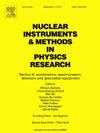Studies of F- impurities formation in ALICE MID RPC detectors: A comparison between LHC RUN2 and LHC RUN3
IF 1.5
3区 物理与天体物理
Q3 INSTRUMENTS & INSTRUMENTATION
Nuclear Instruments & Methods in Physics Research Section A-accelerators Spectrometers Detectors and Associated Equipment
Pub Date : 2025-04-15
DOI:10.1016/j.nima.2025.170515
引用次数: 0
Abstract
The ALICE Muon Identifier (MID) system consists of 72 single-gap Resistive Plate Chamber (RPC) detectors, operated with a gas mixture of CHF, iCH10, and SF at a ratio of 89.7%/10%/0.3%, along with 37% of relative humidity. The combined effects of background irradiation and the electric field within the detector’s gas gap, together with the high concentration of fluorinated gases used, result in the production of F ions and F-based impurities. During LHC RUN2, a preliminary setup was installed to monitor the formation of these impurities, which could lead to the formation of hydrofluoric acid, damaging the detectors and the gas system irreparably (Abbrescia et al. 2008). This setup successfully demonstrated the production of F and other impurities, and the purifier’s capability to trap them, ensuring the feasibility of operating the gas system in recirculation mode. During LHC LS2, the set up was improved and was commissioned for the restart of LHC RUN3. It consists of a gas chromatograph to monitor the correct composition of the gas mixture and an Ion Selective Electrode setup to measure the F concentration.
This study provides a comprehensive overview of the creation of impurities in the ALICE MID RPC detectors under standard operation. Furthermore, it presents a comparative analysis between the results obtained during LHC RUN2 and those ongoing in LHC RUN3.
ALICE MID - RPC探测器中F-杂质形成的研究:LHC RUN2和LHC RUN3的比较
ALICE μ子识别器(MID)系统由72个单间隙电阻板室(RPC)探测器组成,在C2H2F4、iC4H10和SF6的混合气体中以89.7%/10%/0.3%的比例工作,相对湿度为37%。背景辐射和探测器气隙内电场的综合作用,加上所使用的高浓度氟化气体,导致F-离子和F基杂质的产生。在大型强子对撞机RUN2期间,安装了一个初步装置来监测这些杂质的形成,这些杂质可能导致氢氟酸的形成,对探测器和气体系统造成不可挽回的破坏(Abbrescia et al. 2008)。该装置成功地演示了F -和其他杂质的产生,以及净化器捕获它们的能力,确保了在再循环模式下操作气体系统的可行性。在LHC LS2期间,对该装置进行了改进,并为LHC RUN3的重启进行了调试。它包括一个气相色谱仪,以监测气体混合物的正确组成和一个离子选择电极装置,以测量F−浓度。本研究全面概述了在标准操作下ALICE MID RPC检测器中杂质的产生。此外,还对LHC RUN2和LHC RUN3的实验结果进行了对比分析。
本文章由计算机程序翻译,如有差异,请以英文原文为准。
求助全文
约1分钟内获得全文
求助全文
来源期刊
CiteScore
3.20
自引率
21.40%
发文量
787
审稿时长
1 months
期刊介绍:
Section A of Nuclear Instruments and Methods in Physics Research publishes papers on design, manufacturing and performance of scientific instruments with an emphasis on large scale facilities. This includes the development of particle accelerators, ion sources, beam transport systems and target arrangements as well as the use of secondary phenomena such as synchrotron radiation and free electron lasers. It also includes all types of instrumentation for the detection and spectrometry of radiations from high energy processes and nuclear decays, as well as instrumentation for experiments at nuclear reactors. Specialized electronics for nuclear and other types of spectrometry as well as computerization of measurements and control systems in this area also find their place in the A section.
Theoretical as well as experimental papers are accepted.

 求助内容:
求助内容: 应助结果提醒方式:
应助结果提醒方式:


